IBM has launched faster FlashSystem arrays, in a move that also sees it simplify its block access storage array line-up.
The company now goes to the non-mainframe market with a single storage array family under the FlashSystem name, that uses the same hardware chassis – more or less – and the same software stack for all models. The company is retiring the Storwize brand.
Eric Herzog, IBM’s chief storage marketing officer, produced a slide in the announcement webcast yesterday to illustrate the product line complexity of some of the company’s competitors. He said IBM needed only one product family to cover entry, mid-range and high-end requirements. By contrast Dell EMC has five product families, HPE has four, Hitachi Vantara has three and NetApp and Pure Storage has two.
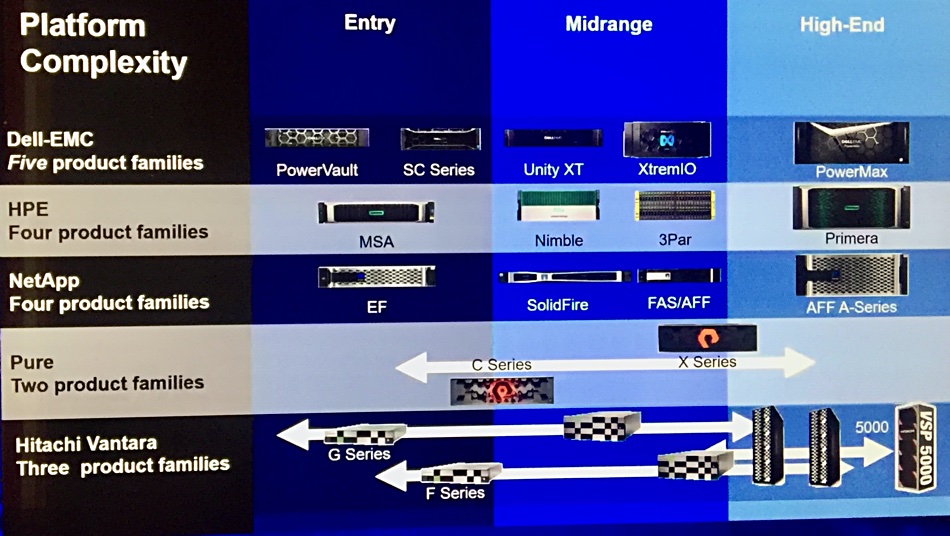
The constituent models of the FlashSystem family are the 5000, 7200, 9300 and 9200R.
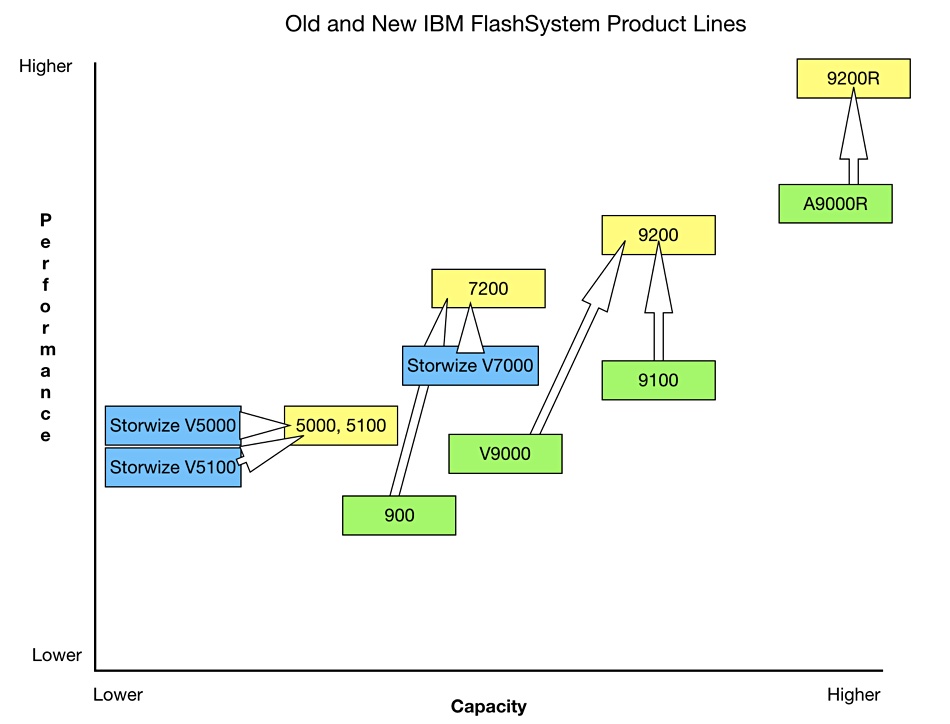
They replace the FlashSystem 900, V9000, 9100 and A9000R systems and the Storwize hybrid flash/disk arrays.
The 9200R – the R stands for ‘Rack’, – has 2, 3 or 4 x 9200 controller chassis in its 42-inch rack and is a pre-configured scale-out, clustered 9200. The other systems come in a dual-controller, 2U rack shelf with 24 front-mounted 2.5-inch drive bays, and the ability to increase capacity using expansion chassis.
New for old
IBM has not specifically said which new FlashSystem replaces which old FlashSystem. But we understand the A9000R replaces the 9200R, while the 9200 replaces the 9100. The 7200, based on the Storwize V7000, appears to replace the V9000.
The old 900 is retired and the re-branded Storwize 5000 is the new entry-level FlashSystem.
The 5000 is actually a renamed Storwize V5000 array and can use SAS disk drives as well as standard SAS SSDs. It delivers around 130,000 IOPS. There is also a FlashSystem 5100 in the 5000 sub-family, renamed Storwize 5100F, and Storwize 5100 models which support SSD, NVMe SSDs, IBM’s proprietary Flash Core Module drives, and also storage class memory (SCM) drives.
The new FlashSystems are positioned in IBM’s overall storage product family in the slide below.
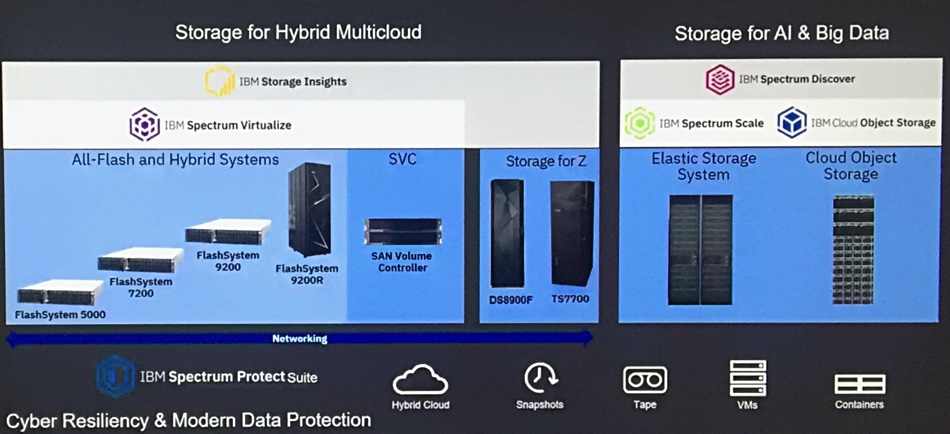
The Storwize arrays do not appear on this slide. Herzog confirmed that the Storwize line is being replaced, telling me via a tweet yesterday that there is “One platform for all our Spectrum Virtualize products.”
The upshot is IBM can claim single system block array bragging rights before Dell EMC, which is yet to launch its MidRange.next system. This is set to replace Dell EMC’s SC, Unity and XtremIO products.
Performance
IBM said the new FlashSystems can deliver up to 18 million IOPS, with latency down to 70μs and bandwidth up to 45GB/sec from a single 9200. That scales out to 180GB/sec. The 7200 and 9200s can deliver up to 10 million IOPS and 136GB/sec, IBM said in a Redbook.
IBM claims the numbers beat the competition and specifically cites Pure Storage’s X90 with SCM cache, which it said has a longer latency of 150μs and slower 18GB/sec bandwidth.
It also calls out Dell EMC PowerMax’s 100μs latency and 15 million IOPS from 80U of enclosures. IBM said the 9200R can deliver its 18 million IOPS from just 8U.
This is a big improvement on the 9200R’s immediate predecessor, the FlashSystem A9000R, which delivers up to 2.4 million IOPS with 250μs latency and up to 26GB/sec. This is largely due to new flash drives.
According to an IBM Spectrum Virtualize FAQ document, the all-flash 9200 has 4 x 16-core processors while the all-flash or hybrid 7200 has 4 x 8-core CPUs, making it less powerful.
Drives and SCM
The all-flash 7200 and 9200 use gen 3 Flash Core Module drives, built from 96-layer Micron NAND, with a dynamic SLC cache. The modules have smart data placement, with hotter read data placed on lower latency pages. The new modules have more IOPS and higher bandwidth than the gen 2 drives. For example, read latency is reduced almost 40 per cent and IOPS increased by 10 to 20 per cent.

These modules are fitted with FPGAs, NVMe interfaces, and hardware compression and encryption. There is system-wide FlashSystem encryption to the FIPS 140-2 standard with USB-based or key server management.
The capacities are 4.8TB, 9.6TB, 19.2TB, and 38.4TB – the latter is twice the limit of the previous Flash Core Modules. That enables up to 4PB of effective capacity in a 2U chassis. The 9200 can scale up to 32PB of effective capacity and out to 128PB with a 4-way cluster.
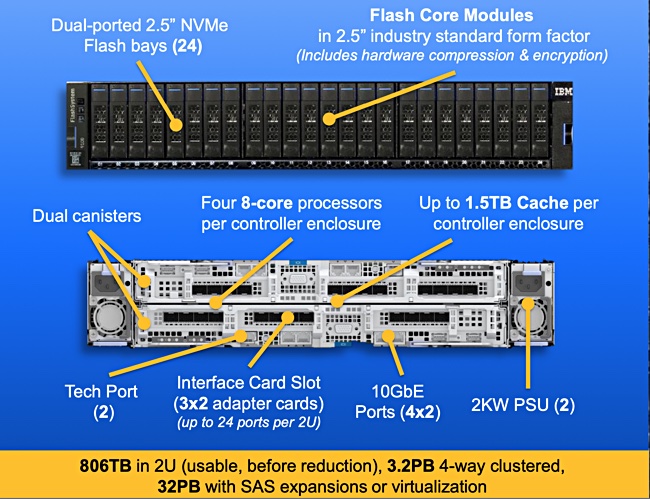
The 7200 and 9200 support up to 4 Intel Optane and Samsung Z-SSD storage-class memory drives in capacities of 375GB and 750GB for Optane, and 800GB and 1.6TB for the Z-SSD. They are supported as an additional tier of storage, not as a cache.
A pre-existing EasyTier function, with AI technology included, automatically identifies the coolest blocks of datas and moves them to the most economical storage tier, looking at SCM, SSD and disk tiers.
Software and more
IBM FlashSystems run Spectrum Virtualize software, as before, and inherit capabilities such as EasyTier and HyperSwap business continuity and disaster recovery. There is 2- and 3-site replication, with replicated volumes and stretched logical volumes available. Data can be sent to the cloud for business continuity and DR, DevOps, analytics and so on.
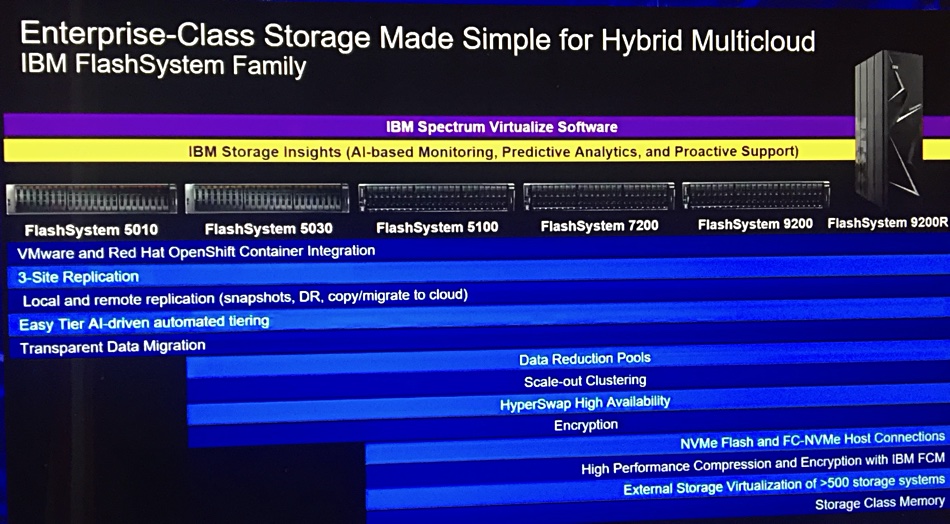
The software supports VMware VASA, vVol and SRM protocols – making the life of the vSphere admin’s easier – and also Kubernetes, Red Hat OpenShift and the Container Storage Interface, facilitating use in cloud-native environments. Red Hat’s Ansible playbook orchestration is also supported for the automation of common storage admin tasks.
IBM Storage Insights service monitors the FlashSystem arrays, receiving 23 million telemetry readings a day from each array, according to Herzog and fixes up to 66 per cent of problems automatically.
The arrays can be monitored by an AI-based system for malware and ransomware infections, and data stored on air-gapped tape or logical air-gapped cloud volumes for extra security. Alternatively Spectrum Control can manage and monitor the arrays on-premises.
Consumption model
The systems can be bought, leased, paid for quarterly on a utility model, or obtained on a subscription basis. There are so-called Flash Momentum upgrade arrangements so users can upgrade controllers and capacity with no upfront payments.
Users can get configuration best practices for target databases, etc, from an IBM Advisor website.
Availability and pricing
The Storwize V5100 and V7000, and FlashSystem 9100 and A9000 will continue shipping until the end of the year. IBM says migration to the new FlashSystems should be straightforward as they share the Spectrum Virtualize operating system.
Pricing starts down at $16,000 for FlashSystem 5000 and rises to a million bucks or more for a 9200R.








